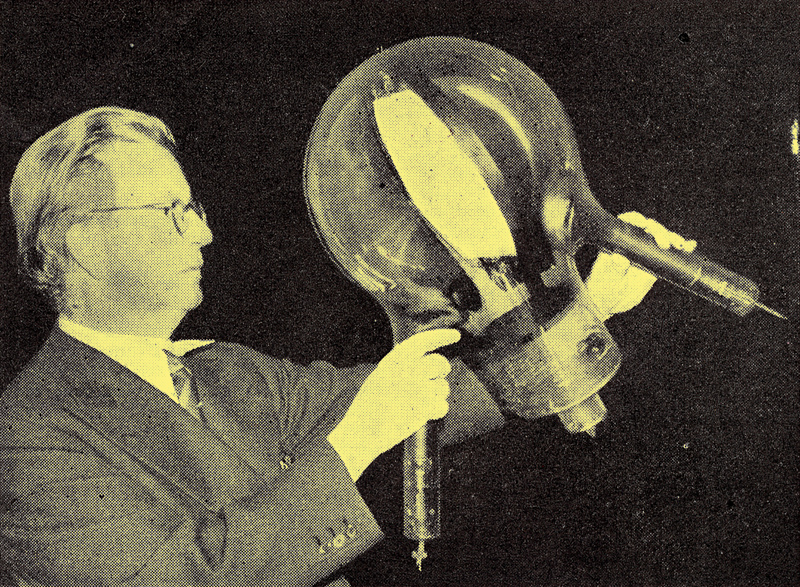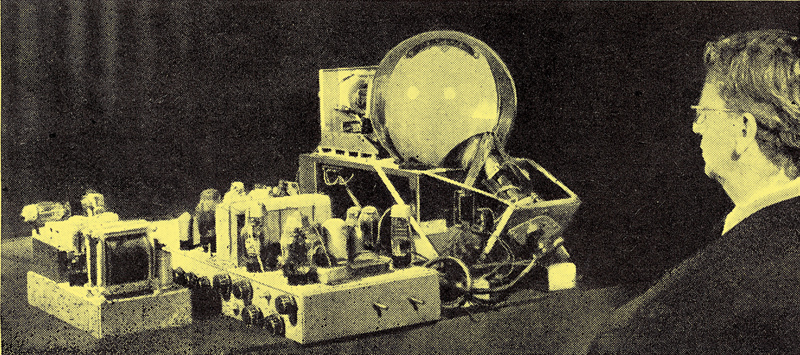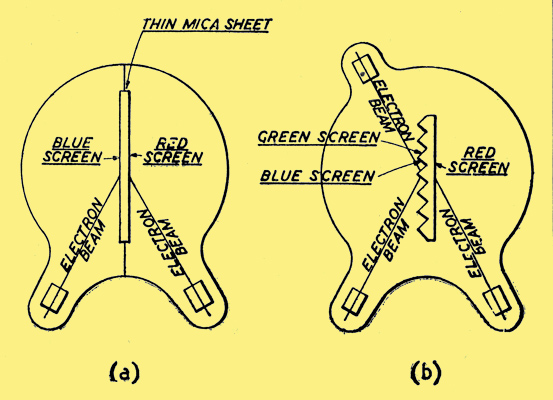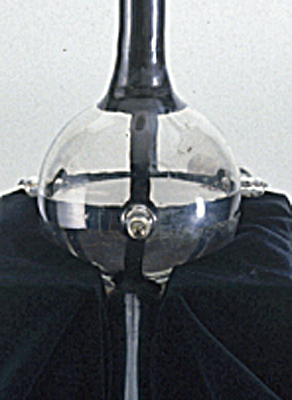|
Cathode-Ray Colour and Stereoscopic Television Receiver

With this type of cathode-ray tube, in which the picture may be viewed on both sides of the screen, the potential size of the audience is doubled.

Complete receiving equipment showing tube designed for viewing from one side only.
The difficulties of research and development under wartime conditions have not sufficed to deter Mr J L Baird from his pursuit of a commercially practicable stereoscopic colour television system. Between 1941 and 1943 he demonstrated three optical projection methods of transmitting pictures in colour and three dimensions, each of which was a noteworthy step forward in quality and realism but suffered from the limitations either of being restricted to individual viewers, involving the use of revolving shutters or lacking brilliance through loss of light in filters.
All these objections have been successfully overcome in his latest system, termed the 'Telechrome', in which the picture is viewed directly on the screen of a cathode-ray tube as in conventional television receivers. The fluorescent screen is a thin mica disc coated on both sides and mounted inside a spherical bulb. One side is coated with blue-green and the other with orange-red fluorescent material and two cathode-ray beams from 'guns' sealed into opposite sides of the containing bulb provide separate excitation for the back and front surfaces.
The transmitter employs 600-line triple-interlaced scanning and a revolving disc interposes orange-red and blue-green filters for alternate frames. The 3:2 relationship between colour and frames ensures that large areas of any one colour do not show line striations. At the receiver the two colour elements combine to give a picture in natural colour, which, in one form of tube can be viewed from both sides, though one group of viewers in this case get a reverse image of the original scene.
By scanning alternate frames through the mirror system described in this journal dated February, I942, and viewing the resultant displaced images through spectacles with the corresponding colour filters for the left and right eye, excellent stereoscopic depth of vision is obtained. Colour can be combined with stereoscopic vision in this system by further breaking up each frame into colour elements, but the resultant picture is in the nature of a compromise and it would seem that for the time being it would be better to use either colour or stereoscopic effects separately according to the nature of the programme material.
Advantages of the present system are that it does not call for a wider frequency band than that used in pre-war television transmissions; and the non-stereoscopic pictures can be received in mono-chrome on existing television receivers.
Given a wider channel width the system could be extended to use three colour elements by using a screen of transparent plastic material with a series of parallel ridges moulded in the back surface. One side of each ridge would then be coated with green and the other with blue fluorescent material, the red coating being used for the plane front surface, as in the two-colour system.
Another improvement in course of development is a scanning system in which successive lines instead of successive frames are of different colours. If the number of lines is made a non-multiple of the number of colours, all traces of flicker should be removed.

Schematic arrangement of cathode-ray tubes used in the Baird 'Telechrome' system; (a) two-colour, (b) three-colour.
Baird only made prototypes of the 'Telechrome' tube (ed.) The example in Bradford was made in 1944. Ian Baird, curator of television has made a short film about the 'Telechrome'.

The only remaining 'Telechrome' tube is at the National Media Museum.

The central sphere enlarged.
|